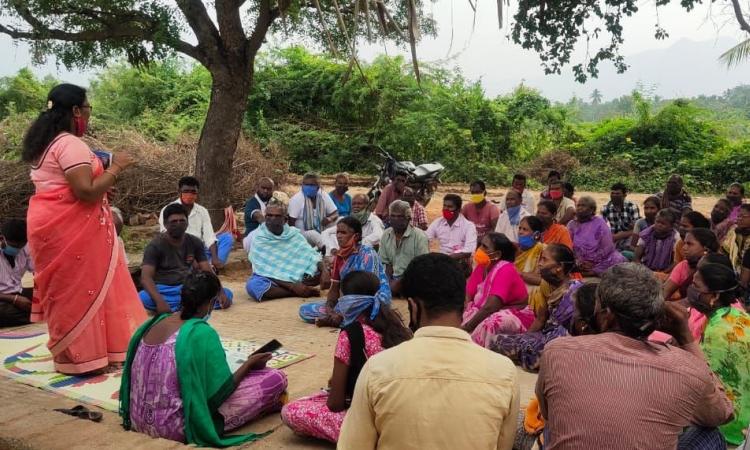
What does IEC-HRD mean for large-scale programs such as Jal Jeevan Mission (JJM)?
Information, Education, Communication (IEC) and Human Resource Development (HRD) activities act as catalysts for behaviour change linked to sustainable development. Any developmental work comes with new infrastructure, systems and procedure, and operations and maintenance of the systems. Such infrastructure, systems, and procedures need to be owned and effectively managed by the stakeholders for long term benefits. Without proper awareness of the technicalities, recommended usage and maintenance; the system and infrastructure can collapse easily leading to huge financial losses, environmental damages, institutional failures, and social changes. This in turn adds a lot of burden to the government exchequer and social coherence. Hence, to bring change in behaviour, bring transparency, increase awareness and build capacities; IEC and HRD activities are playing vital roles in these missions. JJM is a case in point.

Image: RDPR Department, Govt. of Karnataka
What was the approach and media used for JJM IEC-HRD in Karnataka for different audience sets?
We followed an integrated approach with multiple partners for the IEC-HRD activities at State level to convey messages and stories for both JJM and Swachh Bharat Mission (SBM). Different media have been tried and tested. For example, creatives are prepared by using content derived from field and training material by the experts within the department. Empanelled professional video agencies create videos on success stories and capacity building. Community radios, All India Radio, newspapers, magazines and television channels are used for disseminating the content through interviews, live phone-in programs, and dramas.
All the creatives are being published on our social media platforms (Facebook, Instagram, Twitter, YouTube, WhatsApp, Slideshare, Website) which are managed by an agency. We have an exclusive five-member team for managing the social media pages and creating content to go through these channels. We post this creative content every day. Our Facebook page has about 86,000 followers and YouTube channel has over 12,000 subscribers. It has been a fairly successful way to reach the masses with low effort. Apart from these, we have also printed advertisements on KSRTC buses to make the campaign more visible.
In your opinion, what works the best to create behaviour changes in water use and management?
“Reiteration through branding and creative content creation”
We generally have one theme every month. Creative content is made on those themes. This helps in reiteration of the message and assimilating in better ways. Dissemination of these content pieces happens through various platforms: social media, NGO partners (ISAs), field campaigns, and wall writing.
We have also brought in a culture of embedded brandings and logos for our water supply infrastructure and solid/liquid waste management units. These will have a long-lasting impact on the memory and behaviour of people.

Image: RDPR Department, Govt. of Karnataka
How do you measure the success or effectiveness of an IEC-HRD approach?
We have conducted a third-party assessment of our IEC-HRD activities. Two organisations (Athena and Azim Premji University) have independently assessed the impact and given recommendations. Also, other organizations are independently conducting field level studies. Such studies are helping us modify our strategy.
How are you managing complaints received from citizens?
We have established a call centre "Parihara", where we register grievances on a web portal. A complaint registration number is generated and a message is sent to the complainant and the concerned officer also gets a message on his mobile. Once the grievance is resolved the same is updated on the web portal.

Image: RDPR Department, Govt. of Karnataka
What does it take in terms of resources and materials to roll out a large-scale IEC approach? How did you do it in JJM and SBM (G)?
Reusing existing content is important. In an attempt to create a repository of reusable content, we have been posting content on slide share so that other states can leverage it when needed. Most of the content is available both in Kannada and English. We have empanelled video agencies who document success stories as well as create training videos on VWSC, sanitation and water-related aspects. These videos are generally small but the duration ranges from 3 to 30 minutes. We are also uploading short awareness videos on YouTube.
We have deployed a team of human resources in the state and district offices. At the State level, we have a team of IEC-HRD consultants and sanitation and hygiene promotion consultants. In the districts, we have a seven-member team for program management.
At the district level, we also have Implementation Support Agencies (ISA) who have been selected following the due tender process. These ISAs play a key role in IEC-HRD and work with communities.
How well has convergence with other programs and departments on water?
We are integrating with various other schemes. For example, MGNREGA activities help in sustaining water sources. Components in SBM (G) like "Liquid Waste Management (LWM)" address the wastewater generated in households. Funds for LWM are being used from sources of the 15th Finance Commission, MGNREGA and SBM(G). Similarly, Atal Bhujal also works in strengthening water resources.

Image: RDPR Department, Govt. of Karnataka
You can follow their work and access the content created through social media or their website by clicking on the links below: